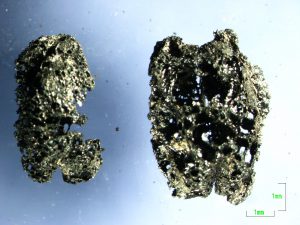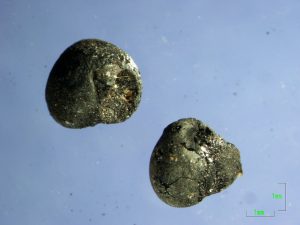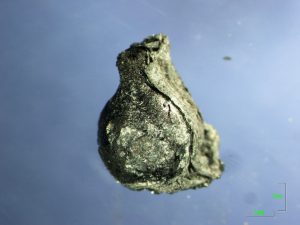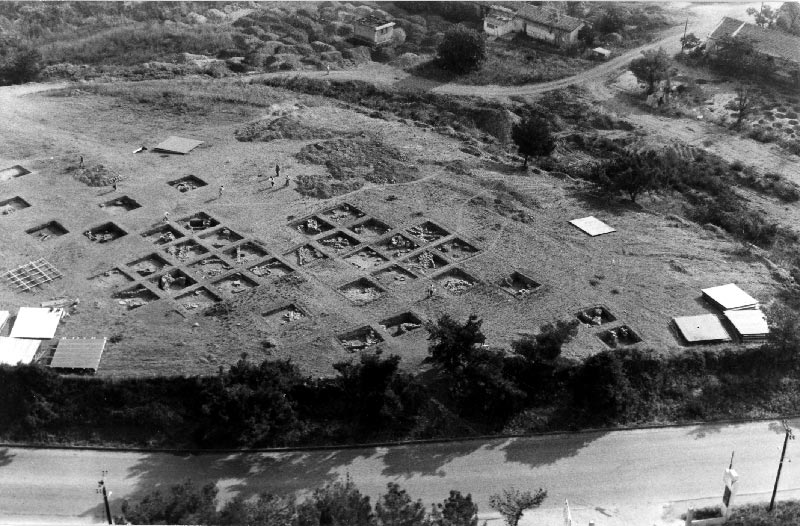Archaeobotanical research at Karabournaki began in 1999 under the supervision of Prof. Soultana Valamoti and has continued since without break within the Laboratory for Interdisciplinary Research in Archaeology (L.I.R.A.) of the Archaeology Department of the Aristotle University of Thessaloniki. A total of 382 samples and 3609 litres of soil have been processed by flotation. The samples retrieved originate from various contexts, mainly the fill of dug out pits found across the site and the beehive-shaped semi-subterranean constructions that constitute one of the principal characteristics of the settlement. Their chronology varies and covers the period from the 8th to the 6th century BC. The archaeobotanical material from the site is currently under study by Prof. Valamoti and Ms Eugenia Gkatzogia, PhD student at the Dept. of Archaeology, Aristotle University of Thessaloniki. Preliminary reports on the archaeobotanical remains finds have been published (Valamoti 2005, Tiverios et al. 2013) and presented at several international conferences (Valamoti and Gkatzogia 2010, Tiverios et al. 2013, Valamoti et al. 2014).
The plant species that have been identified at Karabournaki comprise cereals, pulses, oil plants and fruit. Wild/weed species are also present in the samples in large numbers and comprise a variety of species especially in those samples originating from the pits. The main characteristic of the Karabournaki assemblage is its mixed plant composition deriving from different processing stages such as winnowing, dehusking, sieving and other crop cleaning activities.

Cereals identified at the site include various species of wheat such as einkorn, emmer, “new” glume wheat type, possibly spelt, free-threshing wheat probably corresponding to the tetraploid durum/ macaroni type without, however, excluding the possibility of the presence of bread/ common wheat. Other cereals identified in the assemblage include barley, mainly six row type and less so two row, oat and millet which occurs only sporadically. Cereals consist of both grain and chaff, including silica awns. The main species prevailing among cereals is barley represented mainly by grains, found usually puffed and distorted (Tiverios et al. 2013) that resulted probably from carbonization in high temperatures and/or due to close contact with fire. Einkorn wheat is also prominent in the samples, represented mainly by glume bases. Free-threshing wheat is also present as both grain and rachis internodes.
The pulses identified are lentils, bitter vetch, grass pea, chickpea, possibly common pea and celtic bean. Bitter vetch prevail in the samples and are found in almost pure caches, and found present in many samples.

Fruits include grapes, blackberries, figs and possibly cornelian cherry. Grapes in particular have been found in large numbers. They are represented by grape pips, stalks, loose skins and grape pressings (pips attached to their skins) resulting from the extraction of grape juice. In some samples grapes constitute the main archaeobotanical material and are frequently found across the site, in almost every sample. Grape pressings are found in some pits in great numbers (Valamoti 2005). Oil plants such as opium poppy and Lallemantia are found albeit in small numbers.

Iron Age agriculture in Greece has been little explored (Valamoti et. al. 2014; Livarda 2012; Megaloudi 2006; Kroll 2000) especially for the north of the country, unlike other parts of Europe. Therefore the completion of the archaeobotanical study at Karabournaki will provide substantial information on land use, field crops and harvests from the wild, cuisine and plant ingredients as well as spatial organisation in relation to plant use and discard, in this important Iron Age site of the Thermaic Gulf.
Bibliography
- Kroll, H. 2000. Agriculture and Arboriculture in Mainland Greece. Pallas, 52 : 61-68
- Livarda, A. 2012. “The Archaeobotanical Evidence of the Late Bronze Age and Proto-Geometric Occupation under the Roman Villa Dionysus, Knossos, Crete, and an Overview of the Proto-Geometric Data of Greece”. The Annual of the British School at Athens: p.1-12.
- Megaloudi, F. 2006. Plants and Diet in Greece from Neolithic to Classic Periods: The Archaeobotanical Remains [BAR-IS 1516] (Oxford).
- Tiverios, Μ., Manakidou, Ε., Tsiafakis, D., Valamoti, S.M., Theodoropoulou, T., Gatzogia, E. 2013. Cooking in an Iron Age pit at Karabournaki: An interdisciplinary approach. In Voutsaki, S. and Valamoti, S.M. (eds) Diet, economy and society in the anciet Greek world: towards a better integration of archaeology and science, 205-214.. Peeters, Leuven.
- Valamoti, S.M. and Gkatzogia, E. 2010. Plant remains from an Iron Age cooking installation at Karabournaki, northern Greece. 15th Conference of the International Work Group for Palaeoethnobotany, Abstract Book, Terra Nostra 2010/12, p. 186.
- Valamoti, S.M. 2005. Αρχαιοβοτανικά δεδομένα από το Καραμπουρνάκι: μια προκαταρκτική έκθεση των ευρημάτων (Plant remains from Karabournaki: a preliminary examination of the finds). AEMTH 17, 2003, 201-204.
- Valamoti, S.M., Gkatzogia, E., Slavova, I. and Marinova, E. 2014. Plants in Iron Age culinary practice in SE Europe: continuities and discontinuities in the archaeobotanical record of Greece and Bulgaria. In the 20th Annual Meeting of the European Association of Archaeologists, Istanbul 10-14 September 2014 Abstract Book.
